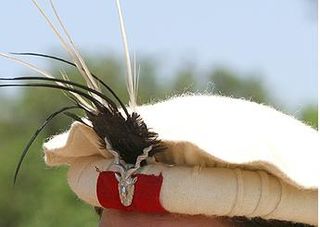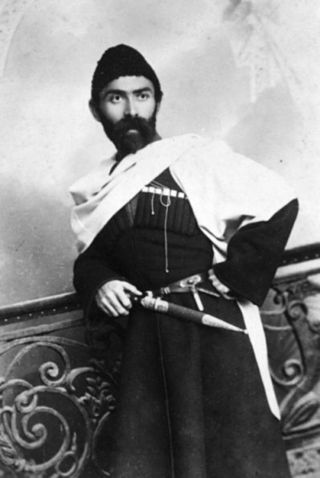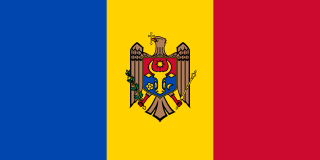
A knit cap, colloquially known as a beanie, is a piece of knitted headwear designed to provide warmth in cold weather. It usually has a simple tapered shape, although more elaborate variants exist. Historically made of wool, it is now often made of synthetic fibers.

A hat is a head covering which is worn for various reasons, including protection against weather conditions, ceremonial reasons such as university graduation, religious reasons, safety, or as a fashion accessory. Hats which incorporate mechanical features, such as visors, spikes, flaps, braces or beer holders shade into the broader category of headgear.

A trilby is a narrow-brimmed type of hat. The trilby was once viewed as the rich man's favored hat; it is sometimes called the "brown trilby" in Britain and was frequently seen at the horse races.

A beret is a soft, round, flat-crowned cap made of hand-knitted wool, crocheted cotton, wool felt, or acrylic fibre.

A straw hat is a wide-brimmed hat woven out of straw or straw-like synthetic materials. Straw hats are a type of sun hat designed to shade the head and face from direct sunlight, but are also used in fashion as a decorative element or a uniform.

The qeleshe, also known as plis and qylat, is a white brimless felt skull cap traditionally worn by Albanians. It has spread throughout Albanian-inhabited territories, and is today part of the traditional costume of the Albanians. The height and shape of the cap varies region to region.

The Asian conical hat is a simple style of conically shaped sun hat notable in modern-day nations and regions of China, Vietnam, Korea, Japan, Philippines, Indonesia, Malaysia, Thailand, Cambodia, Laos, Myanmar, Bangladesh, India, Nepal, and Bhutan. It is kept on the head by a cloth or fiber chin strap, an inner headband, or both.

Pointed hats have been a distinctive item of headgear of a wide range of cultures throughout history. Although often suggesting an ancient Indo-European tradition, they were also traditionally worn by women of Lapland, the Japanese, the Mi'kmaq people of Atlantic Canada, and the Huastecs of Veracruz and Aztec. The Kabiri of New Guinea have the diba, a pointed hat glued together.

The Pakol or Pakul is a soft, flat, rolled-up, round-topped men's cap, usually worn in Afghanistan and northern Pakistan. It is typically made of wool and found in a variety of earthy colours, such as brown, black, grey, ivory, or dyed red using walnut. The pakol is believed to have originated in Chitral and Gilgit, or the Northern Areas in Pakistan.

A chaperon was a form of hood or, later, a highly versatile hat worn by men and women in all parts of Western Europe in the Middle Ages. Initially a utilitarian garment, it first grew a long partly decorative tail behind, and then developed into a complex, versatile and expensive item of headgear after what was originally the vertical opening for the face began to be used as a horizontal opening for the head. The chaperon was especially fashionable in mid-15th century Burgundy, before gradually falling out of fashion in the late-15th century and returning to its utilitarian status. It is the most commonly worn male headgear in Early Netherlandish painting, but its complicated construction is often misunderstood.

The Armenian Taraz, also known as Armenian traditional clothing, reflects a rich cultural tradition. Wool and fur were used by the Armenians along with the cotton that was grown in the fertile valleys. During the Urartian period, silk imported from China was used by royalty. Later, the Armenians cultivated silkworms and produced their own silk.

A bashlyk, also spelled bashlik, is a traditional Turkic, North Caucasian, Iranian, and Cossack cone-shaped hooded headdress, usually of leather, felt or wool, featuring a round topped bonnet with lappets for wrapping around the neck. Local versions determine the trim, which may consist of decorative cords, embroidery, jewelry, metallized strings, fur balls or tassels. Among dozens of versions are winter bashlyks worn atop regular headdress, cotton bashlyks, homeknitted bashlyks, silk bashlyks, scarf bashlyks, down bashlyks, dress bashlyks, jumpsuit-type bashlyks, etc. Bashlyks are used as traditional folk garment, and as uniform headdress.

Romanian traditional clothing refers to the national costume worn by Romanians, who live primarily in Romania and Moldova, with smaller communities in Ukraine and Serbia. Today, the vast majority of Romanians wear modern-style dress on most occasions, and the garments described here largely fell out of use during the 20th century. However, they can still be seen in more remote areas, on special occasions, and at ethnographic and folk events. Each historical region has its own specific variety of costumes.
Textile manufacturing is one of the oldest human activities. The oldest known textiles date back to about 5000 B.C. In order to make textiles, the first requirement is a source of fibre from which a yarn can be made, primarily by spinning. The yarn is processed by knitting or weaving to create cloth. The machine used for weaving is the loom. Cloth is finished by what are described as wet process to become fabric. The fabric may be dyed, printed or decorated by embroidering with coloured yarns.

Headgear, headwear, or headdress is any element of clothing which is worn on one's head, including hats, helmets, turbans and many other types. Headgear is worn for many purposes, including protection against the elements, decoration, or for religious or cultural reasons, including social conventions.
Azerbaijani traditional clothing is the traditional attire of the Azerbaijani people. It is closely connected to its history, religious culture and national identity.

Kazakh clothing, worn by the Kazakh people, is often made of materials suited to the region's extreme climate and the people's nomadic lifestyle. It is commonly decorated with elaborate ornaments made from bird beaks, animal horns, hooves and feet. Although contemporary Kazakhs usually wear Western dress, the Turkic people wear more traditional clothing for holidays and special occasions.

A bumper brim is a millinery feature in which the hat brim is tubular in design, making it a prominent feature of the hat. In order to achieve this effect, the brim may be rolled, stiffened or padded. A bumper brim can be added to a variety of hat designs, from small to large.

Liangmao, also known as Hakka hat and Hakka bamboo hat, is a traditional bamboo and/or straw hat worn by the Hakka people who perform manual work, such as farming and fishing. Hakka women wore it when working in the fields. The liangmao is made and is most commonly worn by the Hakka people who were originally from Northern China. The liangmao is a typical symbol of Hakka culture and is a "unique feature of Hakka culture"; it is also the "most public symbol associated with the Hakka". Some Hakka women still wear the liangmao when working outdoors nowadays. It also worn by non-Hakka women who work outdoors.


































